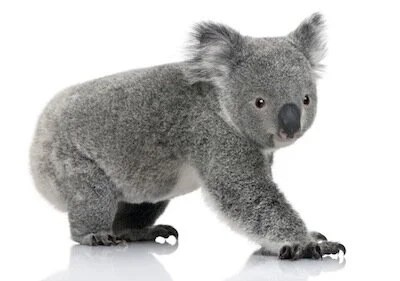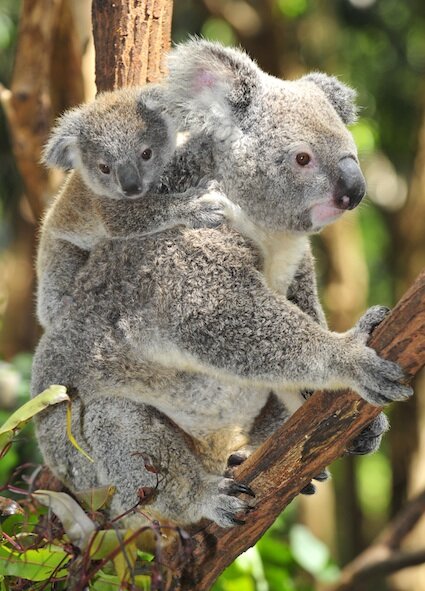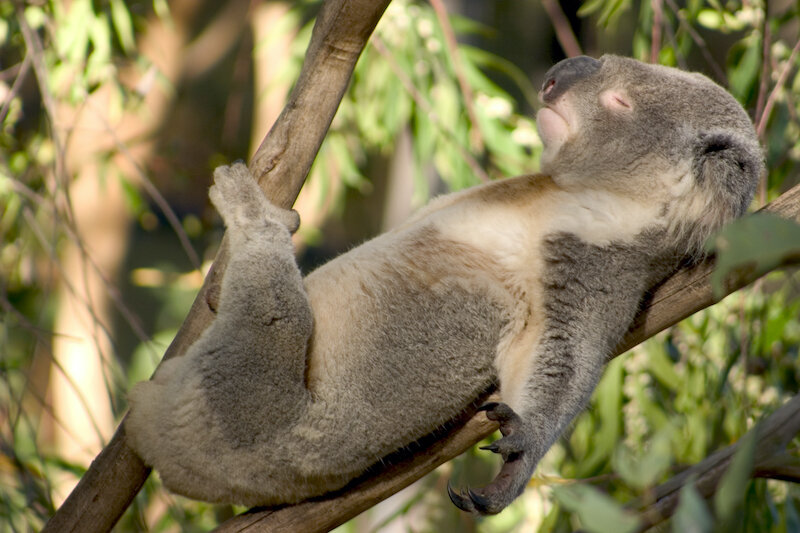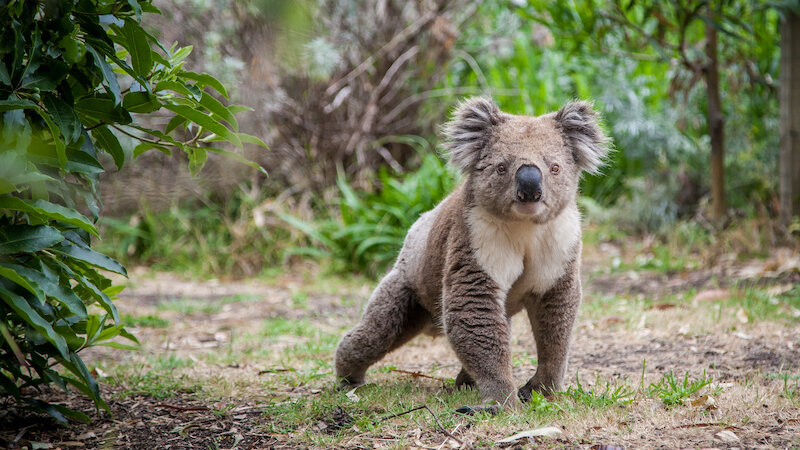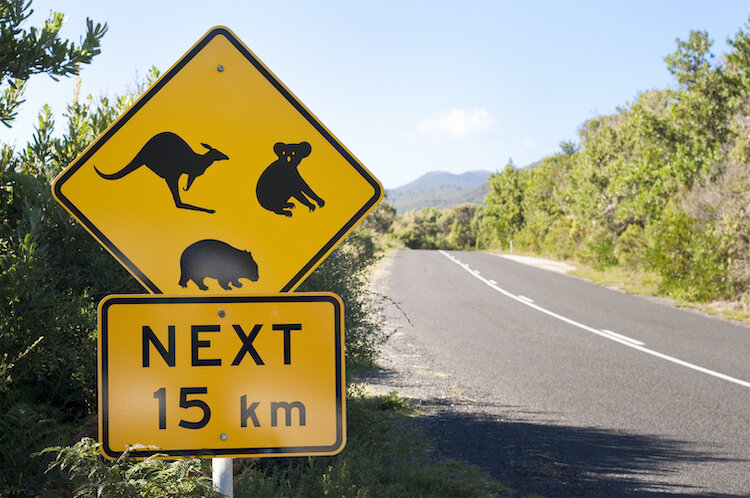Koalas are furry.
They are not bears!
They only eat leaves of gum trees.
They hardly ever drink water.
A baby koala is called a joey.
A joey stays in its mother's pouch for a few months after it is born.
When is a bear not a bear? When it’s a marsupial!
Even though it looks like a bear, the koala is not related to bears at all!
A koala joey riding on its mother’s back. ©Getty Images
It is one of Australia's best known and best-loved animals, and many people call it a koala bear, but its name is just koala. When seen by the first Europeans, they thought it was a bear.
A koala is a marsupial, and bears are not. Marsupial babies are born at an early stage and finish their development in a pouch.
The word 'koala' comes from an Australian Aboriginal word meaning 'no drink'.
Habitat and Distribution (where it is found)
The koala is found in four eastern states: Queensland, New South Wales, Victoria and South Australia. Koalas live in a range of habitats, including all tall eucalypt forests and woodlands. They can only live where the right food trees grow.
Body and Appearance
Koala bodies are adapted to their life in the trees. ©Getty
Koalas have soft, thick, grey or brown fur on their backs. The fur on the stomach is cream or white.
There is only one kind, or species, of koala, and differences in appearance is because of where they live. Koalas that live in the southern parts of Australia have thicker fur than those in the north because of the cold winters, whereas the koalas in the northern part of the country live in warm to hot weather most of the year so have thinner fur.
A koala has a large, hairless nose and round ears. They have an excellent sense of smell and hearing but poor eyesight. Koalas don't have tails, which would make it uncomfortable for them to sit wedged in tree branches, which they do for most of the day. The lower part of their back is quite bony so they can wedge between branches and, lower down still, koalas have thick fur on their bottom so they can sit comfortably for a long time!
Adult koalas measure between 64 to 76 centimetres in length and weigh between 7 and 14 kilograms.
The dark patch on the chest marks where the male's scent gland is located. ©Getty Images
Females have a backward facing pouch, meaning it is upside down so that the young can also feed on leaves when they are old enough.
The mother can grip tight the muscles close to the pouch opening to prevent a joey falling out.
Males have a dark stripe on their chest which has a gland that, as they climb, marks trees with a scent that warns other males not to climb that tree.
Koalas have strong thigh muscles and big claws to help them climb big trees with ease. ©Getty Images
Mammals have a part in the body called a caecum (say see-cm), but in koalas it is unusually long, about 200cm. It contains bacteria to break down the tough fibres of the leaves koalas eat so that nutrition can be absorbed into the body.
Koalas have very strong thigh muscles which enable them to climb up and down tall trees. They have strong, sharp claws and long toes to help them climb.
The koala’s front paws have two thumbs to help them grip branches strongly - the two thumbs go on one side of the branch for better grip, the rest of the claws on the other. The second and third toes on the back legs are joined together to form a grooming claw. The four legs are about the same length.
Koalas have two thumbs on each front paw to assist with holding on to branches. ©Getty
Although mostly silent, koalas communicate with each other using a range of noises ranging from one that sounds like a loud snore, and a burping sound, to a loud bellow.
Diet
Koalas eat the leaves and young shoots of some kinds of eucalyptus (say you-kuh-lip-tus) trees, often called gum trees. In Australia there are over 600 species, or kinds, of eucalypts, but koalas only eat about 20 species. Within a particular area, there will be only three or four species of those eucalypts that will be regularly eaten by koalas. A variety of other species, including some non-eucalypts, are eaten by koalas occasionally or used for just sitting or sleeping in.
Koalas eat the leaves of some kinds of eucalyptus trees ©Getty Images
Different species of eucalypts grow in different parts of Australia, so a koala in Victoria has a very different diet from one in Queensland even though it may seem to be the same. Koalas don't often drink water, as they get moisture from eucalyptus leaves. However, in a severe drought, there is less moisture in leaves so koalas will then need to find water to drink.
Koalas spend a lot of time sleeping ©Getty Images
Koalas spend much of their time asleep.
The reason for this is that so much of their body's energy is needed to digest their food: eucalyptus leaves are very tough and hard. The leaves provide very little nutrition, so a koala has to eat lots of them to get enough nutrition, approximately a kilogram per night for an adult.
Eucalyptus leaves are poisonous to most other mammals.
Behaviours
A male koala on the ground in the process of selecting a new tree ©Getty
Koalas spend nearly all their time in the trees using their sharp, curved claws and long toes to climb about and to hold on to the tree branches.
They sleep most of the day, and feed and move from tree to tree mainly at night. Sometimes they move about in the daytime. They can move quite quickly on the ground.
On country roads road signs warn motorists to be alert to marsupials crossing. ©Getty
Each koala has a home range made up of several trees that they visit regularly. They normally do not visit another koala's home trees except when a male is looking for a female to mate with.
When they are on the ground, koalas are vulnerable. They sometimes cross roads in their search for a new tree, so are often killed or injured by cars. In areas where this is common, road signs warn motorists to be on the lookout.
Life Cycle
A mother with a joey have come down to the ground in order to move to another tree. ©Getty
Breeding season is generally from August to February. During this time the males will be heard bellowing as they compete for females. At this time the young from the previous year are ready to leave their mothers and become independent. Usually a female has one young each year, but may not breed in some years.
Like other marsupials, a baby koala is called a joey.
About 35 days after mating, a tiny baby called a joey is born. It is about 2 cm long, weighs less than 1 gram and is pink, hairless, blind and without ears. Amazingly, this tiny creature travels up its mother's belly and finds the entrance to the pouch. Inside the pouch, it attaches itself to a teat that immediately swells inside its mouth so that the joey cannot let go and lose the teat. The female is able to tighten muscles at the opening of the pouch to prevent the baby falling out.
The joey stays in its mother's pouch for several weeks after it is born and then travels on her back ©Getty Images
The female carries her baby in the pouch for 6 or 7 months after it is born. The baby feeds on its mother's milk inside the pouch. Between 22 and 30 weeks of age, its mother starts feeding the joey a substance called pap, which is formed from pre-digested food and her droppings. This is important, because it contains bacteria from the mother's intestine that will enable the joey to digest the toxic eucalyptus leaves. It is fed to the joey for several weeks before it leaves the pouch.
After it leaves the pouch, the baby travels around on its mother's back, but continues to drink milk until a year old. It is then often referred to as 'back young', now that it is no longer 'pouch young'. Generally this is when a young one leaves its mother, but if she does not breed then the young one stays longer.
Koalas live for about 18 years.
Conservation status and threats
Koalas are classified as Endangered, although this is now being re-assessed. Habitat loss is a major threat for koalas as forests are cleared. When on the ground or low branches, koalas are hunted by dingoes, feral (once domestic but now wild) dogs and foxes. Goannas, wedge-tailed eagles, and large owls are a danger to baby koalas. If there are too many koalas in a small place, usually because much of the forest is cut down, koalas can become stressed, and then ill. When this happens, the government will organise a project to move some of them to a similar habitat elsewhere.
An orphaned joey being hand reared by a wildlife carer. ©Getty Images
From December 2019 through February 2020 there were huge, devastating bushfires in eastern and southern parts of Australia, destroying millions of hectares of bushland as well as farms and homes.
Among the estimated 1.25 billion animals of all kinds that were killed, many koalas were killed or injured. Scientists believe that as a result koala numbers may now be critical and may not recover.
When live young are found in the pouch of a female that has been killed on the road, trained wildlife carers can hand rear the young. In a bushfire, when a female marsupial is killed, small young are protected by her pouch. If found in time they can be hand reared by wildlife carers.
Watch a video about koala conservation efforts
https://thekidshouldseethis.com/post/koalas-101-and-koala-conservation-efforts
Watch a video of koalas in a zoo: you can see them move and eat, see close ups of their hands and a close up of the male's scent patch. You can also hear the male bellow
http://animals.sandiegozoo.org/animals/koala
Read more
©Getty

